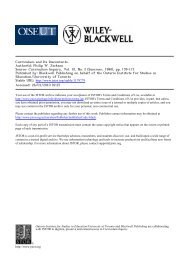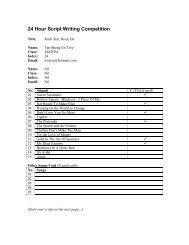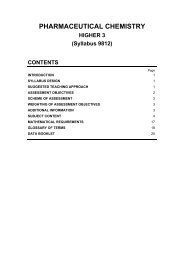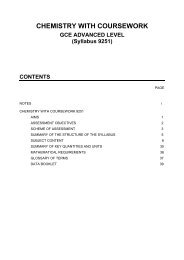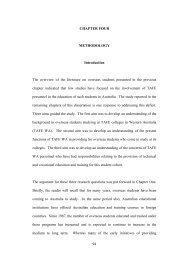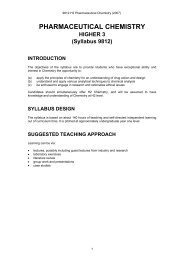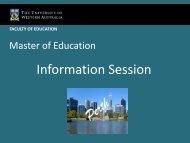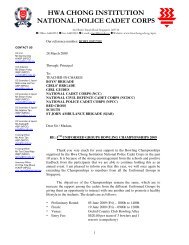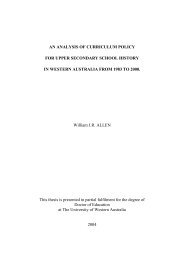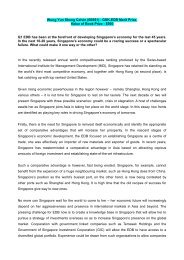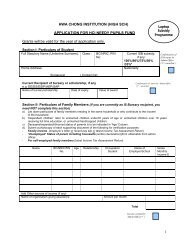Curriculum Ideologies Inventory - Personal Web Server
Curriculum Ideologies Inventory - Personal Web Server
Curriculum Ideologies Inventory - Personal Web Server
You also want an ePaper? Increase the reach of your titles
YUMPU automatically turns print PDFs into web optimized ePapers that Google loves.
<strong>Curriculum</strong><br />
<strong>Ideologies</strong> <strong>Inventory</strong><br />
❖<br />
Instructions for graphing the results and interpreting the results of the inventory are<br />
found on pages 216–218 of <strong>Curriculum</strong> Theory: Conflicting Visions and Enduring<br />
Concerns, the book that accompanies this <strong>Web</strong> site.<br />
39
40 ❖ EXTENSION ACTIVITIES<br />
Instructions<br />
Part 1<br />
Part 2<br />
Part 3<br />
In each of the following sections you will find four statements with a blank in front of<br />
each. Read each statement carefully and then rank the statements from 1 to 4, placing:<br />
1 next to the statement that you like most<br />
2 next to the statement that you like second most<br />
3 next to the statement that you like third most<br />
4 next to the statement that you dislike the most<br />
Use each of the numbers (1, 2, 3, and 4) only once in each part of the inventory.<br />
Place the numbers on the lines to the left of each statement. This is not a test. There is<br />
no one right answer. Take your time.<br />
____ Schools should provide children with the ability to perceive problems in society, envision<br />
a better society, and act to change society so that there is social justice and a<br />
better life for all people.<br />
____ Schools should fulfill the needs of society by efficiently training youth to function as<br />
mature constructive members of society.<br />
____ Schools should be communities where the accumulated knowledge of the culture is<br />
transmitted to the youth.<br />
____ Schools should be enjoyable, stimulating, child-centered environments organized<br />
around the developmental needs and interests of children as those needs and interests<br />
present themselves from day to day.<br />
____ Teachers should be supervisors of student learning, utilizing instructional strategies<br />
that will optimize student learning.<br />
____ Teachers should be companions to students, using the environment within which the<br />
student lives to help the student learn.<br />
____ Teachers should be aids to children, helping them learn by presenting them with<br />
experiences from which they can make meaning.<br />
____ Teachers should be knowledgeable people, transmitting that which is known to those<br />
who do not know it.<br />
____ Learning best proceeds when the student is presented with the appropriate stimulus<br />
materials and positive reinforcement.<br />
____ Learning best proceeds when the teacher clearly and accurately presents to the<br />
student that knowledge which the student is to acquire.<br />
____ Learning best takes place when children are motivated to actively engage in experiences<br />
that allow them to create their own knowledge and understanding of the world<br />
in which they live.<br />
____ Learning best occurs when a student confronts a real social crisis and participates in<br />
the construction of a solution to that crisis.
<strong>Curriculum</strong> <strong>Ideologies</strong> <strong>Inventory</strong> ❖ 41<br />
Part 4<br />
____ The knowledge of most worth is the structured knowledge and ways of thinking that<br />
have come to be valued by the culture over time.<br />
____ The knowledge of most worth is the personal meaning of oneself and of one’s world<br />
that comes from one’s direct experience in the world and one’s personal response to<br />
such experience.<br />
____ The knowledge of most worth is the specific skills and capabilities for action that<br />
allow an individual to live a constructive life.<br />
____ The knowledge of most worth is a set of social ideals, a commitment to those ideals,<br />
and an understanding of how to implement those ideals.<br />
Part 5<br />
____ Childhood is essentially a time of learning in preparation for adulthood, when one<br />
will be a constructive, contributing member of society.<br />
____ Childhood is essentially a period of intellectual development highlighted by growing<br />
reasoning ability and capacity for memory that results in ever greater absorption of<br />
cultural knowledge.<br />
____ Childhood is essentially a time when children unfold according to their own innate<br />
natures, felt needs, organic impulses, and internal timetables. The focus is on children<br />
as they are during childhood rather than as they might be as adults.<br />
____ Childhood is essentially a time for practice in and preparation for acting upon society<br />
to improve both oneself and the nature of society.<br />
Part 6<br />
____ Evaluation should objectively indicate to others whether or not students can or cannot<br />
perform specific skills. Its purpose is to certify students’ competence to perform<br />
specific tasks.<br />
____ Evaluation should continuously diagnose children’s needs and growth so that further<br />
growth can be promoted by appropriate adjustment of their learning environment. It<br />
is primarily for the children’s benefit, not for comparing children with each other or<br />
measuring them against predetermined standards.<br />
____ Evaluation should be a subjective comparison of students’ performance with their<br />
capabilities. Its purpose is to indicate to both the students and others the extent to<br />
which they are living up to their capabilities.<br />
____ Evaluation should objectively determine the amount of knowledge students have<br />
acquired. It allows students to be ranked from those with the greatest intellectual gain<br />
to those with the least.
42 ❖ EXTENSION ACTIVITIES<br />
<strong>Curriculum</strong> <strong>Ideologies</strong> <strong>Inventory</strong> Graphing Sheet<br />
Graph:<br />
(To access this diagram for your own use, visit www.sagepub.com/schiro_activities.)<br />
Part 1<br />
Purpose<br />
Part 2<br />
Teaching<br />
Part 3<br />
Learning<br />
Part 4<br />
Knowledge<br />
Part 5<br />
Childhood<br />
Part 6<br />
Evaluation<br />
Social<br />
Reconstruction Learner Centered Scholar Academic<br />
Social Efficiency<br />
A-1<br />
A-2<br />
A-3<br />
A-4<br />
B-1<br />
B-2<br />
B-3<br />
B-4<br />
C-1<br />
C-2<br />
C-3<br />
C-4<br />
D-1<br />
D-2<br />
D-3<br />
D-4<br />
Sorting Form:<br />
Part 1 Part 2 Part 3 Part 4 Part 5 Part 6<br />
C ___ D ___ D ___ A ___ D ___ D ___<br />
D ___ C ___ A ___ B ___ A ___ B ___<br />
A ___ B ___ B ___ D ___ B ___ C ___<br />
B ___ A ___ C ___ C ___ C ___ A ___



